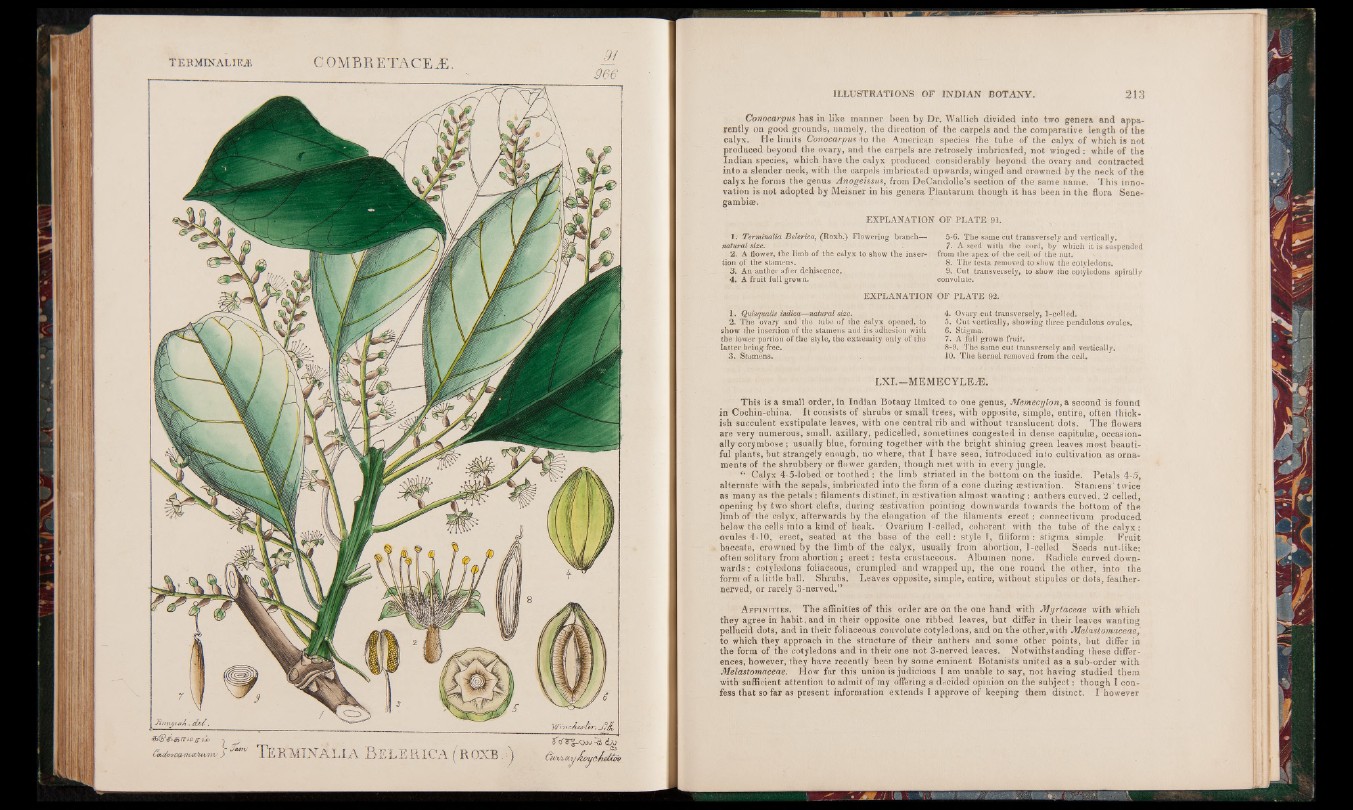
t e r m in a l™.® COMBRETACE/E —
966
s& ftm irw x r ii, j ....
(SasS>0ca»«w«wJ y'""' EERMINALIA BELEPACA ( ROXB ) &VMyJtoyeJidtm
Conocarpus has in like manner been by Dr. Wallich divided into two genera and apparently
on good grounds, namely, the direction of the carpels and the comparalive length of the
calyx. He limits Conocarpus to the American species the tube of the calyx of which is not
produced beyond the ovary, and the carpels are retrosely imbricated, not winged : while of the
Indian species, which have the calyx produced considerably beyond the ovary and contracted
into a slender neck, with the carpels imbricated upwards, winged and crowned by the neck of the
calyx he forms the genus Anogeissus, from DeCandolle’s section of the same name. This innovation
is not adopted by Meisner in his genera Plantarum though it has been in the flora Sene-
gambice.
EXPLANATION OF PLATE 91.
1. Terminalia Belerica, (Roxb.) Flowering branch— 5-6. The same cut transversely and vertically.
natural size. 7. A seed with the cord, by which it is suspended
2. A flower, the limb of the calyx to show the inser- from the apex of the cell of the nut.
tion of the stamens. 8. The testa removed to show the cotyledons.
3. An anther after dehiscence. 9. Cut transversely, to show the cotyledons spirally
4. A fruit full grown. convolute.
EXPLANATION OF PLATE 92.
1. Quisqualis indica—natural size.
2. The ovary and the tube of the calyx opened, to
show the insertion of the stamens and its adhesion with
the lower portion of the style, the extremity only of the
latter being free.
3. Stamens.
4. Ovary cut transversely, 1-celled.
5. Cut vertically, showing three pendulous ovules,
6. Stigma..
7. A full grown fruit.
8-9. The same cut transversely and vertically.
10. The kernel removed from the cell.
LXI.—MEMECYLEJ3.
This is a small order, in Indian Botany limited to one genus, Memecylon, a second is found
in Cochin-china. It consists of shrubs or small trees, with opposite, simple, entire, often thick-
ish succulent exstipulate leaves, with one central rib and without translucent dots. The flowers
are very numerous, small, axillary, pedicelled, sometimes congested in dense capitulae, occasionally
corymbose; usually blue, forming together with the bright shining green leaves most beautiful
plants, but strangely enough, no where, that I have seen, introduced into cultivation as ornaments
of the shrubbery or flower garden, though met with in every jungle.
“ Calyx 4-5-lobed or toothed: the limb striated in the bottom on the inside. Petals 4-5,
alternate with the sepals, imbricated into the form of a cone during aestivation. Stamens' twice
as many as the petals : filaments distinct, in aestivation almost wanting : anthers curved, 2 celled,
opening by two short clefts, during aestivation pointing downwards towards the bottom of the
limb of the calyx, afterwards by the elongation of the filaments erect : connectivum produced
below the cells into a kind of beak. Ovarium l-celled, coherent with the tube of the calyx:
ovules 4-10, erect, seated at the base of the cell: style 1, filiform: stigma simple. Fruit
baccate, crowned by the limb of the calyx, usually from abortion, l-celled Seeds nut-like:
often solitary from abortion ; erect: testa crustaceous. Albumen none. Radicle curved downwards
: cotyledons foliaceous, crumpled and wrapped up, the one round the other, into the
form of a little ball. Shrubs. Leaves opposite, simple, entire, without stipules or dots, feather-
nerved, or rarely 3-nerved.”
A f f in it ie s . The affinities of this order are on the one hand with M yrtaceae with which
they agree in habit, and in their opposite one ribbed leaves, but differ in their leaves wanting
pellucid dots, and in their foliaceous convolute cotyledons, and on the other,with Melastomaceae
to which they approach in the structure of their anthers and some other points, but differ in
the form of the cotyledons and in their one not 3-nerved leaves. Notwithstanding these differences,
however, they have recently been by some eminent Botanists united as a sub-order with
Melastomaceae. How far this union is judicious I am unable to say, not having studied them
with sufficient attention to admit of my offering a decided opinion on the subject: though I confess
that so far as present information extends I approve of keeping them disinct. I however